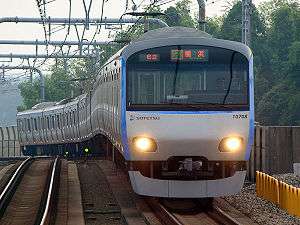Sotetsu 10000 series
| Sotetsu 10000 series | |
|---|---|
|
8-car set in revisedlivery | |
| In service | 2002–Present |
| Manufacturer | JR East Niitsu, Tokyu Car Corporation |
| Number built | 70 cars (8 sets) |
| Formation | 8 or 10 cars per set |
| Operator(s) | Sotetsu |
| Specifications | |
| Car body construction | Stainless steel |
| Car length | 20 m (66 ft) |
| Width | 2,930 mm (9.61 ft) |
| Doors | 4 pairs per side |
| Electric system(s) | 1,500 V DC |
| Current collection method | overhead |
| Safety system(s) | Sōtetsu ATS |
| Track gauge | 1,067 mm (3 ft 6 in) |
The Sotetsu 10000 series (相鉄10000系) is a commuter electric multiple unit (EMU) train operated by the private railway operator Sagami Railway (Sotetsu) in Japan.
History
The trains are based on JR East's E231 series design, and were built to replace ageing 5000, 2100, and 6000 series trains. The 10000 series were constructed by Tokyu Car Corporation in Yokomaha and JR East's Niitsu factory. A total of 70 cars were built, formed as sets.
Formations
As of 1 April 2015, the fleet consists of three 10-car sets and five 8-car sets, formed as follows.
(←Yokohama --- Ebina and Shonandai→)
10-car sets
(10701, 10702, 10708)
- 10700-10200-10100-10600-10300-10600-10600-10200-10100-10500
8-car sets
(10703 to 10707)
- 10700-10200-10100-10600-10600-10200-10100-10500
(10100, 10200, 10300 cars are motored. 10600 is a non-motored trailer.)
Liveries
 10000 series train in original livery, March 2003
10000 series train in original livery, March 2003 Train in promotional livery, June 2007
Train in promotional livery, June 2007
Interior
 Interior view
Interior view
See also
| Wikimedia Commons has media related to Sagami Railway 10000 series. |
This article is issued from Wikipedia - version of the 11/7/2015. The text is available under the Creative Commons Attribution/Share Alike but additional terms may apply for the media files.
